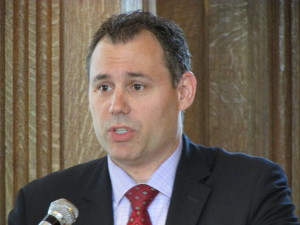Complying with the new regulations tied to the Patient Protection and Affordable Care Act will almost always be less expensive than paying the penalty for not offering health care plans to employees, experts said at a recent panel discussion.
By 2014, employers with more than 50 full-time employees or full-time equivalents will be required to offer their employees health care coverage.

While some business owners have said they”™d rather save their money and pay a penalty for noncompliance, business advisers are encouraging large employers to instead comply with the mandate.
“You have to get your arms up and around this today,” said panelist Russell J. Carpentieri, managing director of Opus Advisory Group L.L.C., at the Westchester Country Club in Harrison. “The cost of compliance is less than the cost of noncompliance.”
The June 11 Navigating Health Care event was organized by Citrin Cooperman & Co. L.L.P., a tax and consulting firm with offices in Norwalk, Conn., and White Plains, among others.
One of the first steps in complying with the regulations is for a company to determine whether it has 50 full-time employees and to determine who of those employees must be offered health care coverage, Carpentieri said.
A company may only have 45 employees working full time at 130 hours a month, but if that company has at least another 10 employees who work 60 hours a month, it would be required to offer all its employees health care coverage, Carpentieri said.
All employees paid by a company are counted toward its total, whether they are part time, seasonal, independent contractors, union employees or hired through a staffing agency. Although these employees count toward the total, they don”™t necessarily need to be offered health insurance, Carpentieri said. Only full-time employees and their dependents must be offered “affordable” coverage. Affordability is determined on an individual basis. For plans to be deemed affordable, they must cost less than 9.5 percent of an employee”™s annual income, Carpentieri said.
If employees don”™t have access to an affordable plan and their income is between 100 percent and 400 percent of the federal poverty level, they are eligible to receive tax credits toward buying a plan on a state-based insurance exchange.
However, if a full-time employee at a firm with 50 or more full-time staff or equivalents uses federal tax credits to pay for insurance that is marketed through a state exchange, the employer will be fined $3,000 per employee using the tax subsidy. If that company doesn”™t offer its employees any health coverage in the first place, it will be charged $2,000 for every full-time employee on staff.
Panelist Jason Madrak, chief marketing officer of Access Health CT ”“ which is Connecticut”™s health insurance exchange ”“ said government officials recognize the complexities of the Affordable Care Act. Madrak said it could be up to five years before the system stabilizes and provides real cost savings for every consumer.
“The insurance marketplace is for the most part wildly dysfunctional,” Madrak said. “To address the dysfunction, they put a crazy, patchwork system ”“ with a whole slew of tax incentives, subsidies and stipends ”“ in place in order to plug the holes at all sorts of levels.”
Despite the complexities, Madrak said the goal of the Affordable Care Act ”“ to provide consumers with access to affordable health care ”“ would ultimately be achieved.
Carpentieri however, said he wasn”™t so sure, especially because it has yet to be seen whether the market will offer plans that allow employers to be in compliance with the law.
“I think it”™s one of the most damaging bits of legislation to businesses; I really do,” Carpentieri said. “Best thing we can do is hunker down, play some strategy and see where it goes.”




















Comments 1